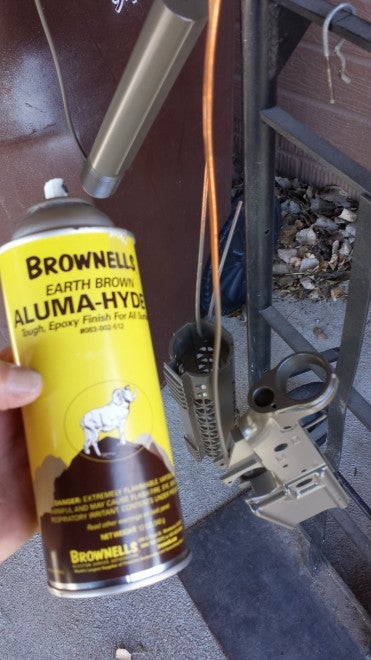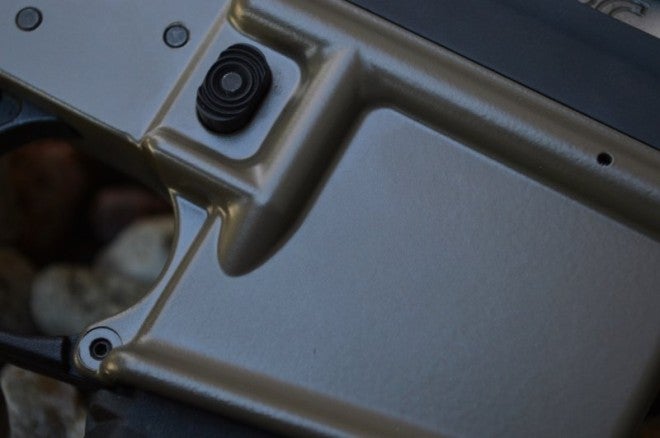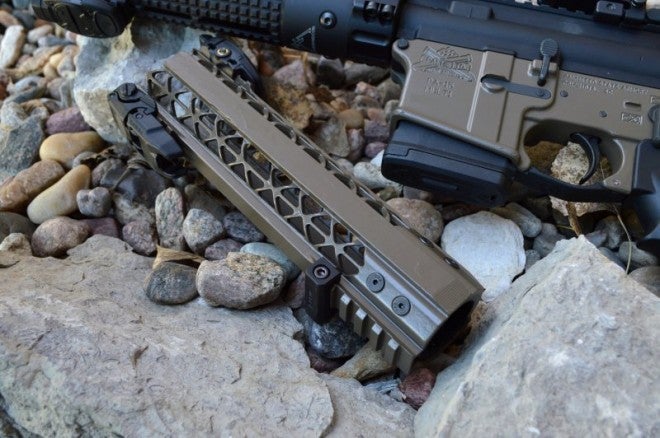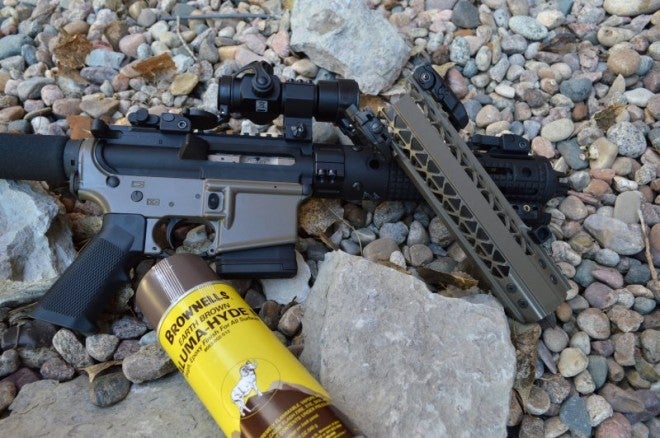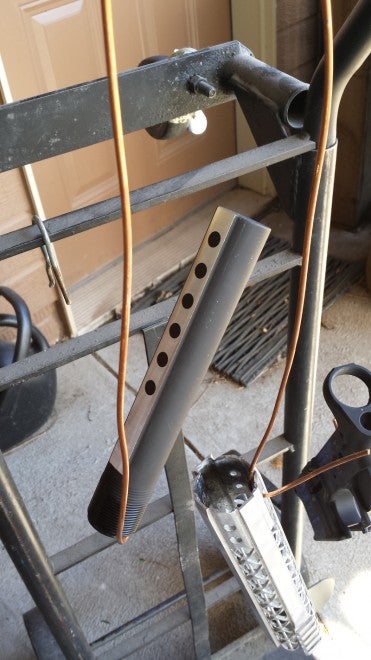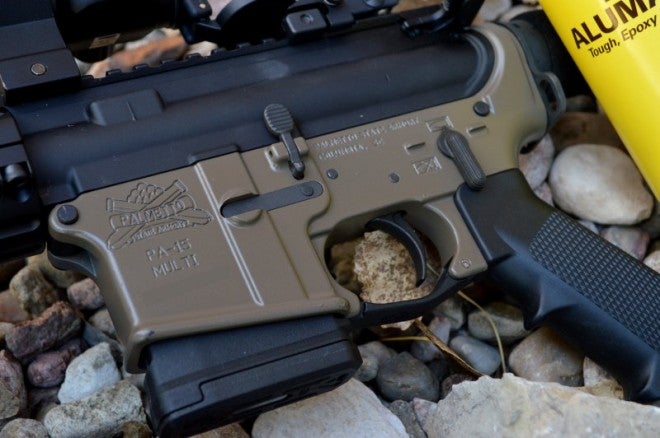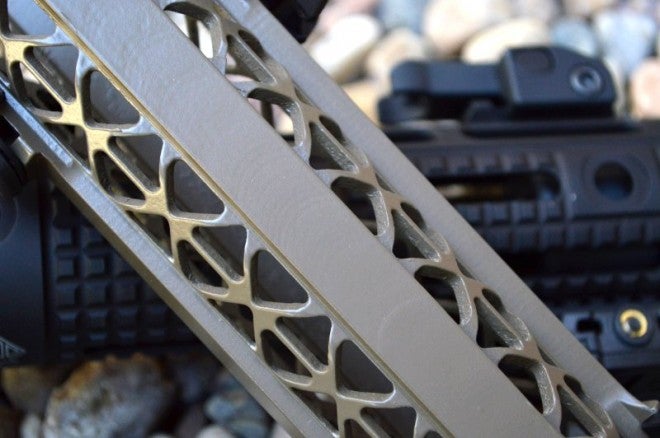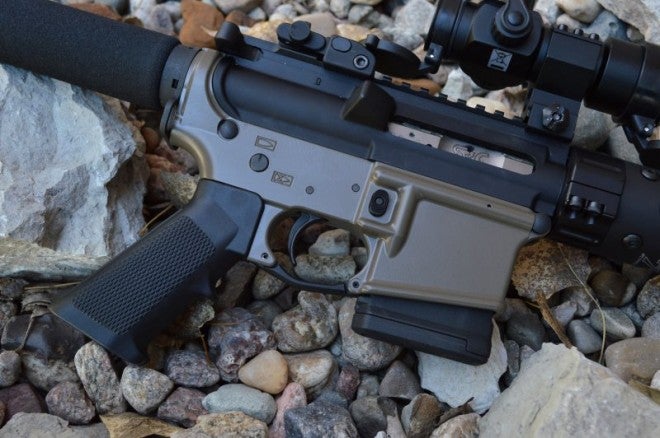Review: Brownell’s Aluma-Hyde II Spray-On Gun Finish
Major Pandemic 08.03.16

So you want to change your firearm’s color? You could go with something like Duracoat or Cerakote, roughly $200 and about two months of separation from your precious firearm. But many gun lovers are also do-it-yourselfers who want something faster and less expensive–something we can do at home.
Brownells Aluma-Hyde II gives you a durable DIY option for customizing and protecting your firearm, and I have found it to be pretty darn good. It easily resists aggressive fingernail scratches and remains unaffected by the harsh cleaning chemicals used on our firearms, and it does all this for $12.99 per spray can.
I have heard much conjecture about this firearm epoxy paint. Some say it is just remarketed Krylon enamel or some downgraded Duracoat finish. But if we get down to it, Aluma-Hyde II is basically the same as readily-available VHT Epoxy appliance spray paint, which is usually available in gloss colors of tan, white, and black. Brownells Aluma-Hyde II is offered in around a dozen shades of camo and other gun finish colors.
Oddly enough, it was the smell of the stuff that I recognized and remembered from when I’d repainted a couple old refrigerators long ago. Fifteen years later, those fridges have taken a beating, but that finish is still there.
The $8 appliance epoxy spray paint I mentioned is available in hardware stores, but generally they are glossy and not in typical “gun colors.” Brownell colors are flat and semi-gloss, and that’s where the extra five bucks per can comes in. You can use any of the hardware store appliance spray epoxy paints to achieve the same results, but colors are limited and they will be high-gloss, requiring a light buff with steel wool to take the gloss off after final curing
I picked up can of “Earth Brown” Aluma-Hyde for a AR15 pistol build I was working on. Initially I was skeptical about the coating, so I chose to use a $39 blemish lower receiver along with the customized Black Rain Ordnance stripped, chopped, and milled forend. I also painted my buffer tube, which was a DIY pistol buffer tube from which I had milled off the entire buttstock rail interface.
Like appliance epoxy spray paint, the Brownells Alma-Hyde II is not regular spray paint, and if you treat it like it is, your results will suck. Epoxy spray paint was originally designed for use in marine environments, but it works well on anything that needs a very tightly sealed and durable coating. You do need to ensure your coated parts are immaculately clean. The easiest way to achieve cleanliness of parts is to fully strip and clean parts, then liberally soak them down with spray brake cleaner, rinse with clear water, and air dry using a heat gun or blow dryer to speed things along.
“Real” epoxy paint requires mixing paint with a hardener, but spray-can epoxy relies on warm parts and a long cure time. Users have four basic phases: a tack-coat phase (0-60 minutes), short-cure phase promoted by a low heat source (60 minutes-24 hours), long-cure (1-14 days), and finally the fully-cured phase.
Generally, you will be able to reassemble parts 24-48 hours after painting *if* a low heat source is applied. I recommend just letting everything fully cure for a couple of weeks; otherwise I guarantee your fingernail will end up finding and damaging that one area that is still soft like I did on some later projects.
Once the pristinely-cleaned and dried parts are ready, you should hang them on heavy wire hooks. I made my hooks from electrical wire and hung them on my 2-wheeled cart outside. Cure time will decrease if the can and parts are warm, so gently warming the parts and can on a furnace register can really help you get a harder finish faster.
At this point, applying the Brownells Aluma-Hyde II is similar to applying spray lacquer, which means many very light coats. If you try to rush with heavy or even medium coats, you will get lots of runs and drips, which equals a crappy-looking final finish and in some cases waiting for several weeks for the finish to be hard enough to sand down and recoat. Be patient and use thin coats.
Once you are done with six or so light coats of your chosen Brownells Aluma-Hyde II, you can move the parts carefully inside. I say carefully, because this is where I bumped one part into another and added a few imperfections to a near-perfect finish. Once I had the parts safely hanging indoors, I pointed a couple utility lights on the parts to keep them around 90 degrees and let them “cook” under the lights overnight. The overnight low heat cure worked well but, a second slightly higher temp 100-115 degree cure in the oven overnight delivered a harder final finish and will speed the final long term cure considerably.
I freaked out a bit when I heard that people “had to” bake the parts to get a hard finish. This is simply not true. Aluma-Hyde II will cure fully in about two weeks, but if you are an impatient SOB like me, a low-temp oven cure is the answer. Initially, I also imagined placing still-wet parts into my wife’s oven and ending up with a mess and an angry wife, but this too was incorrect
In my opinion, parts should not be placed in an oven until a day or two after they have been sprayed. One of the parts that was a little tacky when I put it in the oven had some finish issues. If you do choose to bake your Aluma-Hyde II parts, it should be no messier than just placing dry-to-the-touch parts on a sheet pan in the oven overnight. I did use a piece of cooking parchment paper to separate the pan from the parts, just in case Aluma-Hyde II somehow came off of the parts, which it did not.
Normally, rattle-can epoxy paints will continue to cure for a couple weeks. Even three weeks later a nose on the part will still detect the scent of curing paint.
Oddly enough, the lower receiver was fingernail-hard at the 48-hour mark after the lamp cure and oven cure, but handguard (which received a thicker coating of paint) took nearly a week to get to the same hardness. In reality, if you don’t want to cock up a perfectly good paint finish, I would wait at least two weeks to assemble the painted parts. It’s a great, low-cost DIY durable finish, I just never said it was fast.
If you talk with many of the professional finishing and coating places, most will end up air-curing your painted parts for a week or two before shipment just to ensure the final product is as durable as it can be when it gets to you.
Final Thoughts
The final result after allowing a full cure is quite impressive. In fact I would say that if you take your time and do a good job applying many light coats, it is every bit as good as most premium spray-on firearms finishes, with the exception of CeraKote.
Sure, this super durable paint will wear through eventually (all will), but it is exponentially more durable than every other rattle can finish I have used on firearms, and it will not melt away when a drop of gun cleaner hits it. And if it does get beat-up after a few years, you can just recoat it yourself without needing to strip off the old finish.
The finish offers some corrosion and weather resistance and, if applied as directed, will produce a pretty impervious finish to the elements. What I like is that an old, beat-up firearm can have new life and a new look with just $12.99 of Aluma-Hyde II, and if you start combining colors for a camo look, things could get really interesting.
Descriptions on Brownells site and the pictures of the colors are not particularly accurate. You may have to experiment with the colors to find the shade that matches your furniture or expectations.
The “Earth Brown” I purchased is pretty close to old WWII army Jeep green, so I am somewhat convinced that whoever named these was partially colorblind and has been confused at the sight of brown stoplights for years.
The green color is okay, but not what I wanted or was expecting. Just be aware that the colors as described, pictured, or shown on the cap may not be quite what you get on the final product.
Those who get in a hurry, lack patience, and like to take shortcuts should avoid Brownells Aluma-Hyde II because it will never meet your expectations. But if you are willing to do the job correctly, the results are impressive, durable, and transformational for only $12.99.
Specs
- Approximately a dozen different colors
- $12.99 per 12-ounce aerosol can
- Available in spray can or bulk liquid for airbrush application (thinner sold separately)
